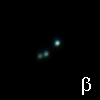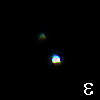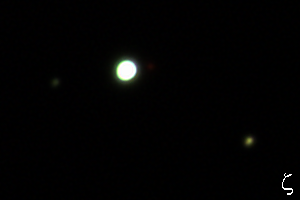

The Unicorn is a legendary rather than a mythological creature. It was known to the Greeks, but described in treatises on natural history rather than in the stories of the gods. The constellation is not original and seems to originate with Petrus Plancius, a Dutch cartographer, in the early 17th century, but it may be earlier.
Canis Minor, however, represents the little dog that is so important in the story of Bootes. I cover the constellation in full elsewhere
Monoceros is a fairly large constellation but contains only two stars brighter than 4th magnitude, α at 3.93 and γ at 3.98. However the Milkyway passes through the constellation so it is rich in faint stars and clusters. There is only one Messier object, M50 an open cluster, but I have included another of Messier's open clusters, M48 which is just over the eastern boarder in Hydra. In addition M46 and M47 are just across the southern border in Pupis and just outside my picture. (These two constellations are too far south for me to be able to image them in full.) There are many open clusters in Monoceros and I am not able to indicate them all. However there are six grouped together around NGC 2239 and I have imaged those at higher magnification below.
There are a number of reflection nebulae in the constellation, the best known being NGC 2261 (Caldwell 46), Hubble's Variable Nebula. Discovered by William Herschel in 1783, Hubble studied it in 1915 and discovered it appeared quite different to its appearence in 1908. Working with the more-experienced Barnard he realised the nebula was illuminated by a variable star, called R Monocerotis although it is largely obscured by the nebula, but the brightness of the nebula does not seem to follow that of the star. The nebula is small (2 × 1 arc-minutes) and lies about 5° south of NGC 2264. It can be seen in a picture from the Hubble telescope here.
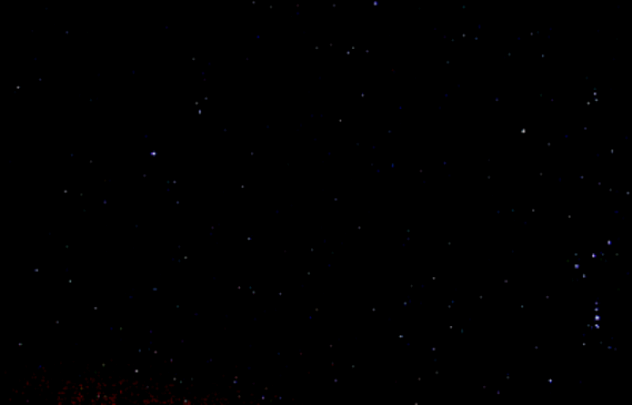
|
This image was made with a Canon 1000D with its own 28-mm lens, an exposure of 30 seconds at f/4 and ISO 1600. It was enhanced by increasing the contrast and gamma, and a red, background glow removed in PhotoImpact. The scale of this picture is about 25% greater than other pictures of constellations using these optics. Move your mouse pointer over the image to see identifications of the major stars and clusters and I have indicated where the boundaries of the constellations are. Where I have marked NGC2339 there are in fact six open clusters and I have shown these in a larger-scale picture below. At the bottom of this page is a picture of NGC2264 which surrounds 15-Monocerotis. I have included M48 even though it is just over the boarder in Hydra. M46 and M47 are just outside the bottom of my picture in the nearby constellation of Pupis. |
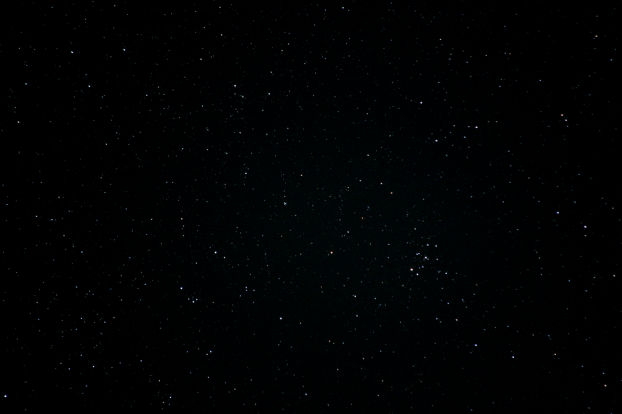
|
This picture of the clusters around NGC2239 is at a larger scale. There are six open clusters. Move your mouse pointer over the image to see identifications of these clusters. I have used Cartes du Ciel to locate and size the circles on the image. NGC2239 is at the centre of the Rosette Nebula (NGC 2238); the two together are known as NGC 2237. There is a nice image here. This image was made with a Canon 1000D with a USM 70-300 lens at 300mm, an exposure of 30 seconds at f/5.6 and ISO 1600. It was enhanced by increasing the contrast, and gamma and a red, background glow removed in PhotoImpact. |
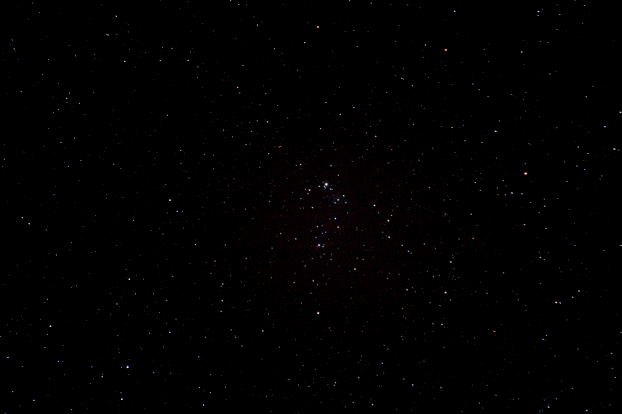
|
This image of NGC 2264, in the far north of the constellation was made with a Canon 1000D with a USM 70-300 lens at 300mm, an exposure of 60 seconds at f/5.6 and ISO 1600. It was enhanced by increasing the contrast, and gamma and a red, background glow removed in PhotoImpact. Move your mouse pointer over the image to see the cluster identified. It is known as the Christmas Tree cluster which is apparent if you turn the picture up side down. There is nebulosity associated with the cluster known as the Cone Nebula. The NGC designation refers to both objects. There is a nice picture of them here. |
β is a triple star described by Herschel, who discovered the fact, as "one of the most beautiful sights in the heavens". ζ is another triple, and ε is a double. There are lots of others.
